Painting an Urban Watercolor on Clear Gesso
In a previous post, I mentioned an experiment with an urban building facade, painted in watercolor on clear gesso coated watercolor paper. You asked why, and what, and how, so lemme ‘splain….
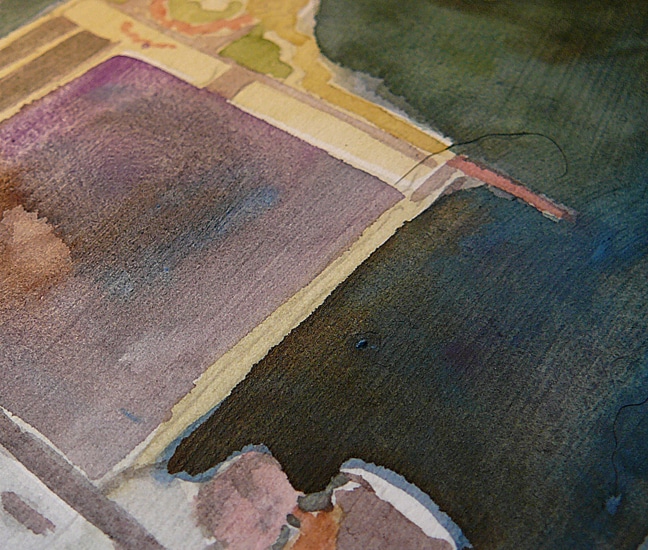
What is Gesso?
Gesso is an artist’s painting primer that feels similar to plaster. It’s applied to canvas, wood, Masonite and other artist supports.
The word gesso is derived from Greek (γύψος), meaning Gypsum, or chalk. It’s usually white, and is made from acrylic resin, pigments, chalk, gypsum and a binder. It can be formulated to prohibit absorption, like sizing, or it can encourage it.
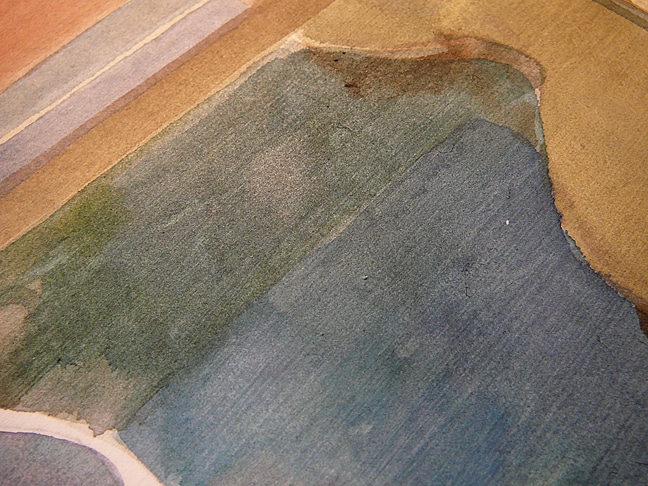
Painting Like the Masters
I took a semester on Painting like the Masters many years ago in college.
We used powdered pigments with egg yoke binders (egg tempera). We made gesso in the old-world methods – with rabbit skin glue, chalk, and titanium pigments.
We coated our masonite boards 10-15 times in thin layers of homemade gesso. We sanded the gesso to a satin finish, and then painted very detailed, realistic grisaille version of studio still life arrangements. Then we painted over the grisaille in egg tempera.
It was amazing. And it was a lot of work. Nowadays, you can just buy a jar of gesso.
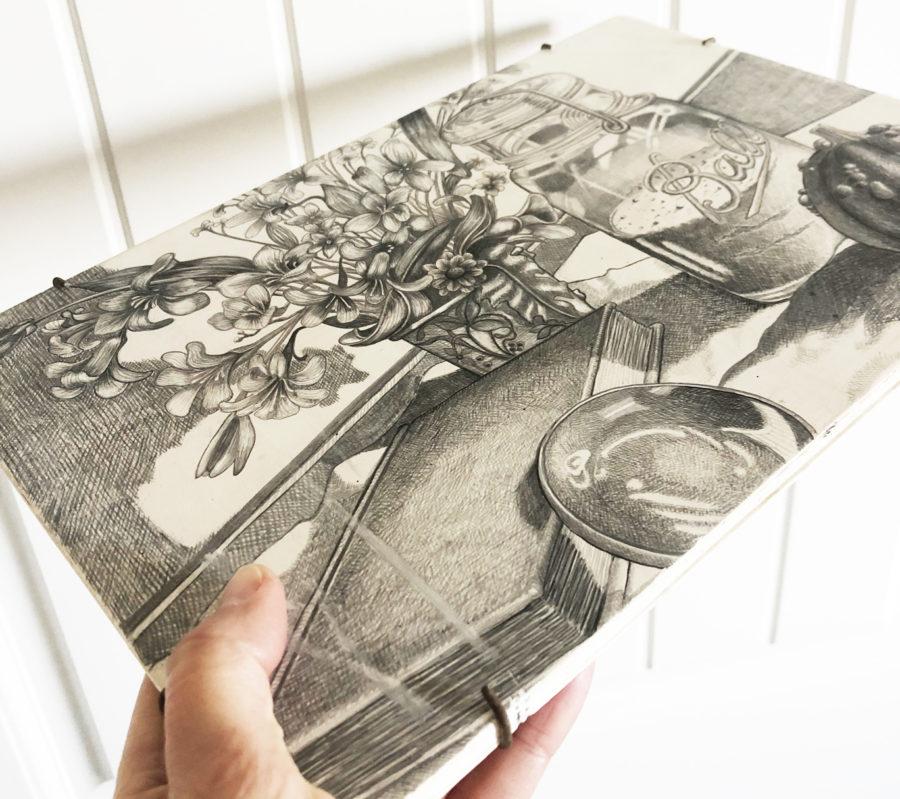
Clear Gesso as Sizing and Texture
Acrylic gesso is easy to use, dries permanent and washes up with water when it’s still wet. Gesso is available pre-mixed for priming canvas, or sizing paper – in white, black, gray and clear.
You can also tint white gesso with any color you’d like by adding a bit of acrylic pigment to it.
I’ve painted watercolor on acrylic gesso before, and it’s very different, and super fun. Mostly because you can lift the watercolor and get back to white, or close to it.
I’m curious to see if granulation in watercolor behaves different on clear gesso. I won’t be able to answer my own question till I set up a side-by-side gesso strip – one white and one clear. If you beat me to it, leave a comment on your results and let us all know.
For now, I totally enjoyed the way the clear gesso “drank” the paint, bled at the edges, prohibiting my being fussy, and allowed me to lift back to white. The gesso also took many layers of paint, so I could push values towards darker, richer hues.
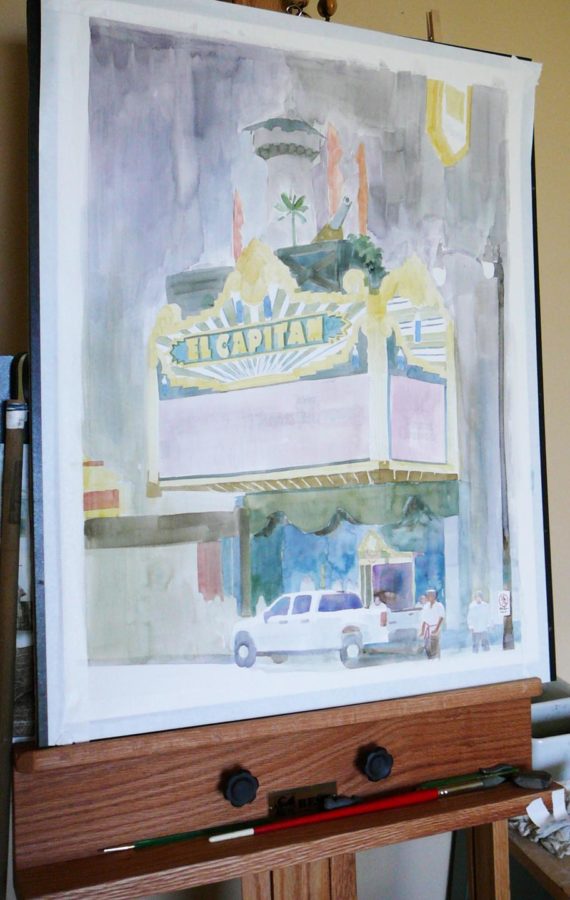
Using a Grid System of Drawing Under Watercolors
If you grid your paper to lay your drawing down in graphite before you paint – like I do – clear gesso allows you to see your drawing.
Sometimes, I paint on a warmer white paper – not as bright as white gesso. I could tint the gesso to warm it up, but I found it easier to skip that step, and use clear gesso on warmer toned paper.
Painting on gesso can be smooth or rough. If you want it smooth, you’ll have to take your support to a well ventilated area, and sand it.
I used a foam applicator to apply the clear gesso to paper, and intentionally slopped it on willy-nilly. The surface was rough.
Since I was planning to paint a vertical theater facade, I kept my gesso application stripes vertical. The resulting surface was a bit like painting on fine sand paper. The pigments soaked in, spread out and did all sorts of wonderful mingling.
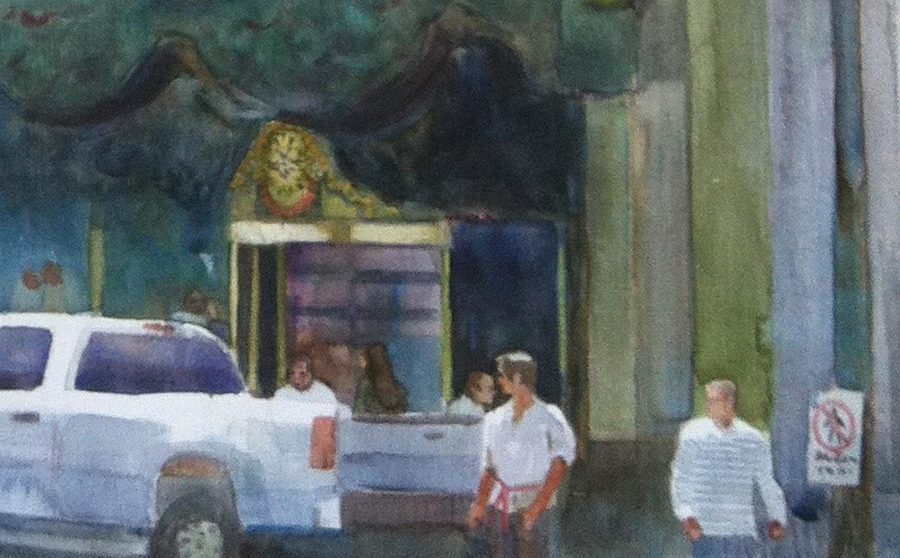
Other Applications for Clear Gesso
I can just imagine what the texture of this clear gesso would do for holding pastels (eye-brow wag – rubbing hands together). Maybe even on top of watercolors?
And I had an idea the other day about tinting it with a small amount of acrylic – so it will relay color but stay transparent. If I roll the tinted, sheer gesso on top of a failed monotype, it would alter the hues, and increase the traction for application of colored pencils. A new type of printmaking repair to try, perhaps?
Since I wasn’t sure if I’d like the clear gesso, I bought a small quantity – 8 oz of Liquitex (<–this stuff). So far, it’s great fun, and I think I’ll keep working with it. What say you? Do you think you’ll give it a try?
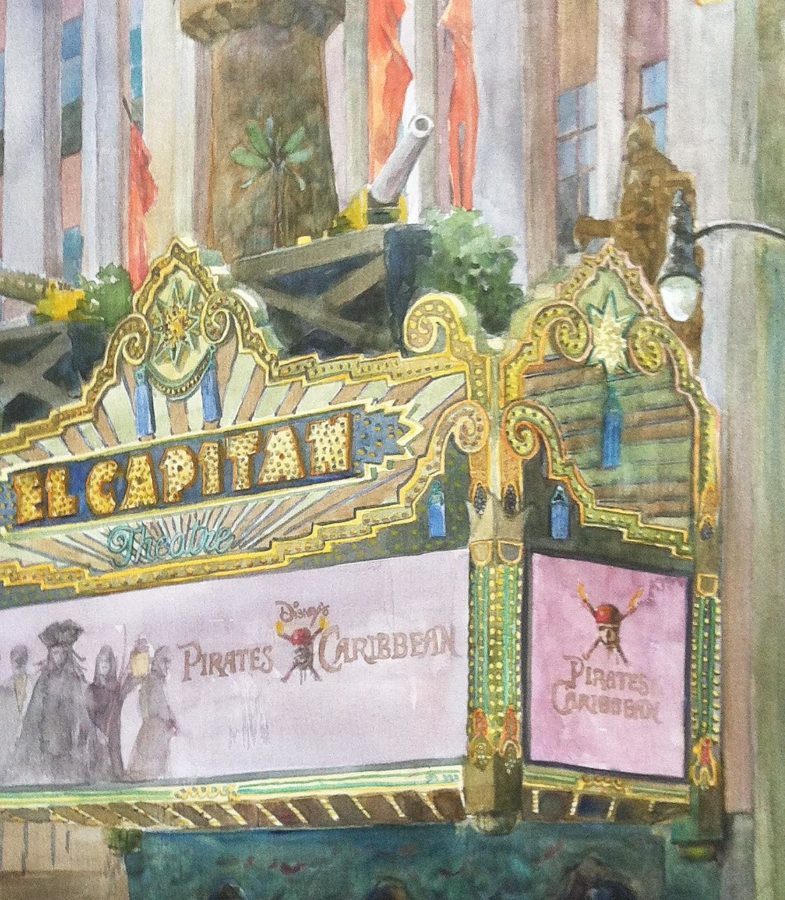
Release the Rules
We are accustomed to using rules, instructions, ingredients lists and process directions to learn new things. Thank goodness for the instructions writers in cookbooks, printmaking manuals and painting guides.
I am forever indebted to those rare characters who possess both visual and wordsmithing skills. We artists need a starting place when trying a new thing. But once we get even a smidgeon of experience, we shouldn’t be afraid to throw caution to the wind and expand our range beyond the instructions.
Art rewards a carefree spirit with experimental permission, and new discoveries. Approaching a creative endeavor with rules is meant to just get us started, so we don’t hurt ourselves, or try to paint a watercolor on top of an oil painting, etc. Acquire the basics, and then goof off.
Creativity is playtime, and shouldn’t be fraught with white knuckled brush-work, brow-beating about expected skills, and holding your breath as you work. Looking at it this way makes it hard to paint often. Keep your art-making fun, and remind yourself that it’s supposed to be experimental, and creative, and exploratory. You’re not preparing for a one person show at the Guggenheim – you’re playing with art.
Thanks for visiting the studio with me, and I’ll see you in the next post –
Belinda
P.S. If you’d like to see my experiments with clear gesso on a failed monotype print, let me know, and I’ll photograph and share how it goes.
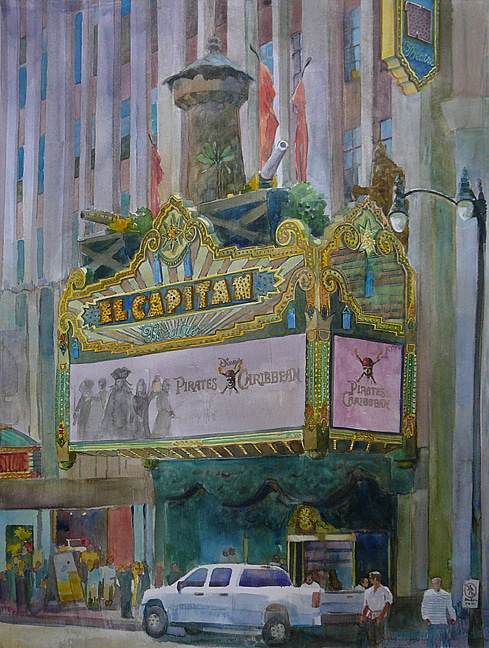
Art Quote
At the rate of almost one birth a year, the Vermeers’ had five or six children by 1661, three of four whom survived. The first children who apparently lived into adulthood were all girls – Maria, Elisabeth, Cornelia, Aleydis, and Beatrix. With an eventual eleven living children, Vermeer may well have pondered how to divide his energies; his slow production of paintings meant he completed only some three pictures for every child. The poet Yeats later put the dilemma as which to choose, perfection of the life or of the work? A ruthless genius may plump for the latter. A more difficult task faces the home-loving artist who tries for both.
Jonathan Jansen
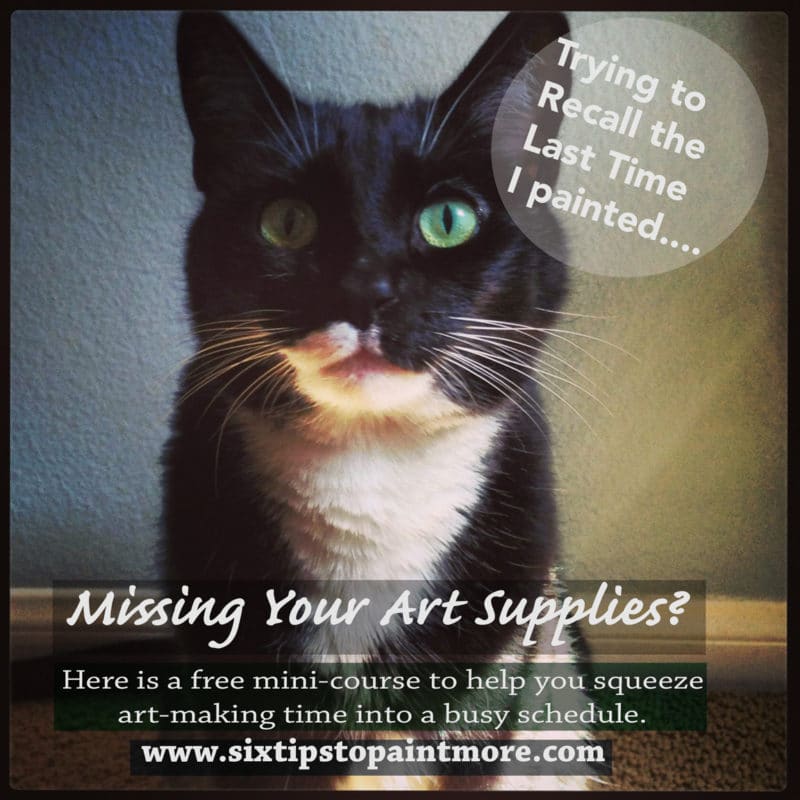

Yes. I’ve done this several times! I have also painted over the clear gesso with watercolors, without drawing first. I painted from an old photo, 1972 of my husband, and from a photo of my daughter. Most were painted when looking at my photos upside down. I can easily remove paint to fix a spot. The painting of my husband was painted over collaged yellowed book pages. In both I used monochromatic paint. Sepia tones. Is it possible to send you pictures?
Hi Bonni, Your clear gesso monochromatic watercolor painting experiments sound AMAZING! What a very cool idea! Direct painting, upside down, on clear gesso, from a familiar/fave photo in a single color! What an assignment! Are the paintings on your Facebook feed?
Hola Belinda muchas gracias por todos sus consejos, por sus atrevimientos en el arte, y también por hacerme aprender a mezclar diferentes técnicas. Soy pintor de acuarelas ya que me gusta mucho esta técnica pero voy a probar empleando Gesso para ver sus texturas.
Nuevamente muchas gracias por sus comentarios.
Hola Hugo, Gracias por tu muy linda nota. Me alegra que el arte y el proceso que estoy compartiendo te sean útiles y espero que tus experimentos con la acuarela y el yeso te lleven a muchas aventuras divertidas. Sigue pintando y que tengas una gran semana.
HI Belinda, Great post. I also love using clear gesso. Sometimes my students will scan a drawing and we will print it out on fine art digital paper. Then, we will coat it with 50% clear gesso and 50% matte medium. They then add watercolor over the printed drawing. It allows them to be much more daring with their color than they might be if it were the original. The reason we cut the clear gesso with the matte medium is that I have found the watercolor sometimes bleeds with the pure clear gesso. Have you had that problem?
Hi Kathleen! Thanks for the feedback. Yayyy that you are another clear gesso user! And your layered process with the gesso and medium mix is awesome. I’ve used it on wood that way, but not on digital fine art paper. I bet your students had a blast experimenting and lifting watercolor on those prepared sheets! And yes, the clear gesso drinks the watercolor like thirsty sand, and the pigment bleeds past the area where you lay it down. All true, and that was what I wanted for this larger piece. Up close, the colors traveled like crazy, but up on a wall, from a usually viewing distance, it made no difference at all.
I’ve used pastels on top of clear gesso on watercolor paper and it’s one of my favorite surfaces to use. I’ve also toned the paper first with a watercolor under painting or just a solid tone. I’ve always thought you couldn’t use watercolor on top of gesso so will have to give it a try. I’ve only ever used the Liquitex clear gesso but I’ve heard others say it’s grittier than other brands and than the Liquitex white gesso.
Hi Diana, You can indeed paint on top of it with watercolors, and I agree that clear gesso is much grittier than traditional, white acrylic gesso. I suspect that the formulation of the white gesso is smoother to help painters skip the sanding process, but I’m guessing. Have you tried toning your clear gesso with a little bit of acrylic before working your pastels into it?
Belinda,
I love the way you approach art – making it fun, taking the fear out of failure, trying new things, playing with color. Just because it hasn’t been done, doesn’t mean that it can’t be done. When people visit my “playroom” they invariably say they couldn’t create an artwork because they don’t have the talent. I always tell them it isn’t about the talent, it’s about playing with all those fabulous colors in all those wonderful mediums and just enjoying the process. If something comes from your efforts, great. If not, it’s been a fun learning experience.
Mickey, I couldn’t have said it better! I know exactly what you mean about the “I have no talent” comments, and “It must be so nice to be an artist. I sure wish I could do that…” Your playroom sounds like a wonder, and I’m so glad you cross the threshold with anticipation of a fun couple of hours, rather then a pressure-based expectation of mastery. Keep sharing your good philosophy, my friend! The world needs you, especially now!
OMG, Belinda! You are a true answer for all my questions, some I didn’t even know I needed! I’m always saying, “Why didn’t I think of that?” Thank you so much for being you and caring about all of us who need a gentle nudge to keep on trying!!! I especially loved your post about older people (me) who have a fear of trying something new! Your encouragement to try printing using grocery store flat containers hit the perfect cord with me and thanks to you I overcame my fear and made one. What fun! I’ll try to send you a copy of it when I get it printed. Thank you so much for caring. Pat
Hi Pat! Thanks so much for your feedback, and for sharing the specifics of your brave exploration of a new art medium! I’m so glad you tried it, and more important, that you had fun with it. Please do share your project when it’s printed… I bet there are many others who would be inspired to give it a go too! Keep on trying, every single day!
This was fascinating and I’m getting some clear gesso! I so look forward to your posts. Your El Capitan is wonderful, no wonder you’re keeping it in your private selection. I’m a white knuckle painter so your written advice will help me get beyond this. You are also a good writer. So thanks!
Hi Leslie, Thanks for your nice note. I’m glad you like the El Capitan painting. (It’s not in my private collection – my son has it at his house. He’s a book/movie/Pirates of the Caribbean fan.) I am a white knuckled painter too, when I don’t remember my own advice. So, we’re working on this together. Deep breath. Write the thing you fear about art-making on a sheet of scrap paper, and then crumple it up, with flourish, and toss it into the bin. 🗑